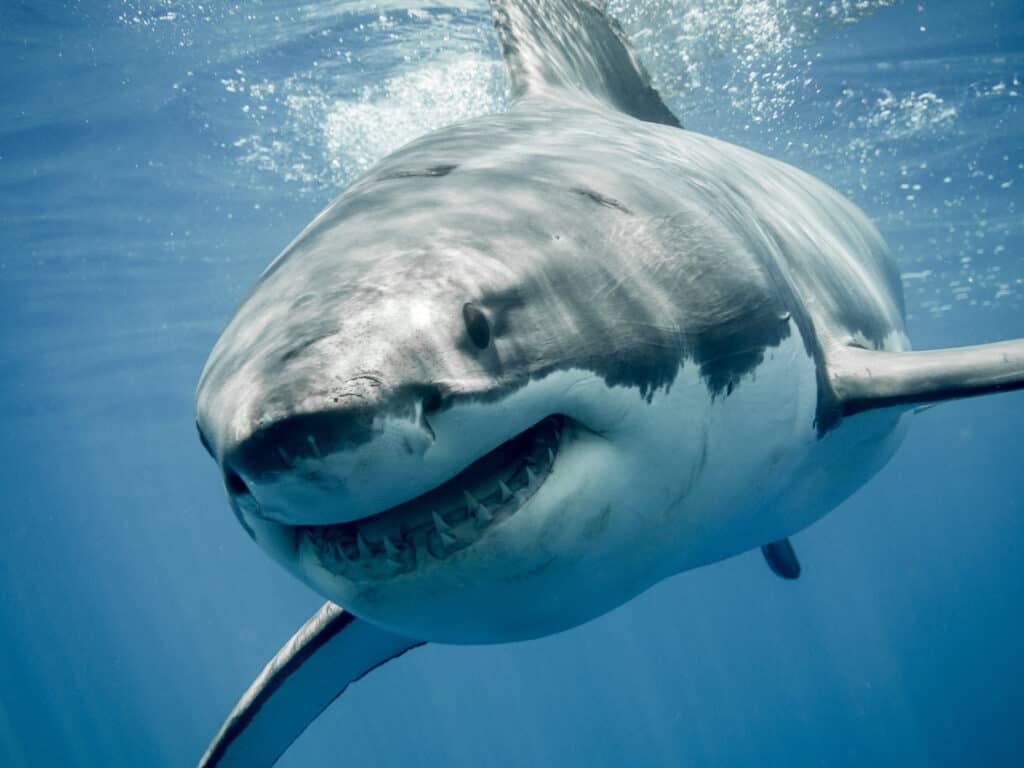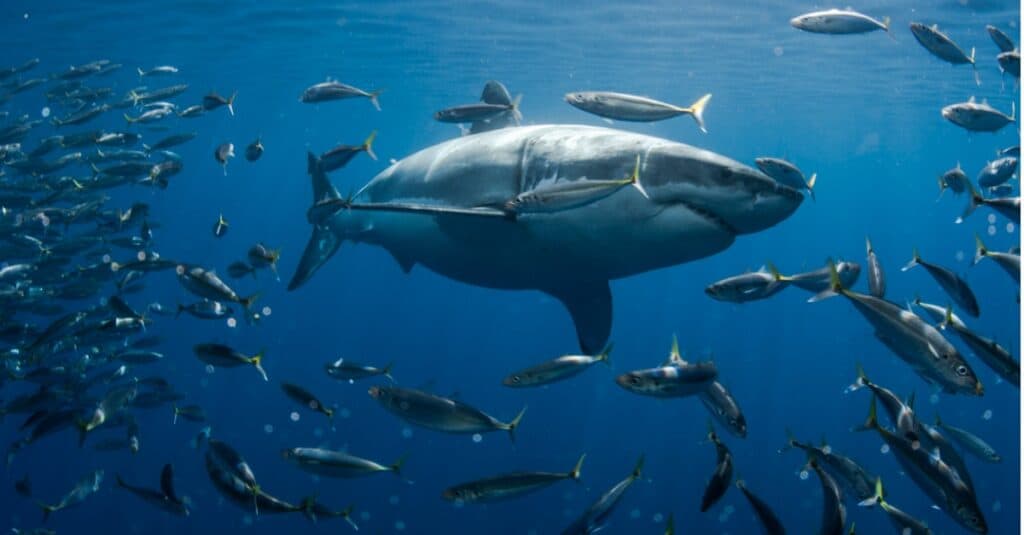The great white shark is one of the most fearsome predators in the ocean. At maximum size, these fish reach upwards of 20 feet long and weigh up to 5,000 lbs. Still, despite their size and predatory fame, great whites aren’t as numerous as many would expect. Part of this is due to their reproductive process, a behavior that humans still know very little about. Today, we will explore this process and discover: How Do Great White Sharks Mate? Plus, we will learn a little more about great white shark babies. Let’s get started!
How do great white sharks mate?

Male great white sharks insert their claspers into the female great white’s cloaca while mating.
©Ramon Carretero/Shutterstock.com
Great white sharks reproduce through the male inserting one of his two claspers (penises in the shape of a modified pelvic fin) into the female shark’s cloaca.
The “process” for shark mating is somewhat similar to what most people are familiar with, although there are a few differences that are worth noting. First is the great white shark anatomy. Great white males don’t have penises, but they do have structures that essentially act as a penis. These structures, known as claspers, are modified pelvic fins that lay externally on the shark’s belly. Instead of having one, however, they have two.
The exact process for great white mating is still relatively unknown, although there are some newly documented examples that give us new insight into the process. Generally, a male and female shark will find shallow water away from a feeding area and begin the process. Once connected belly to belly, they begin to roll together. Often, this process is rough, and the sharks will grasp one another with their teeth, causing scarring across the upper half of the body.
How often do great white sharks mate?
Great white sharks don’t mate all that often. Current estimates have mating occurring once every two years, an incredibly long time compared to other types of sharks.
Part of the reason great whites mate so sparsely is their gestation period. After mating, the total gestation period for great whites is around 11 months, two months longer than a human. Additionally, great white sharks don’t sexually mature until their later years, reducing the potential breeding pool. Historically, scientists believed great whites reach sexual maturity around 15 years old, but recent data shows they may not reach sexual maturity until 26-33 years of age.
Do great white sharks have live young?

Great white sharks are ovoviviparous, a mix between live birth and egg-laying.
©iStock.com/Alessandro De Maddalena
Many shark species lay egg casings or capsules that are often referred to as a “mermaid purse,” but the great white is quite different. In fact, great whites are known to be ovoviviparous, meaning they have eggs that hatch, but the entire process takes place in the uterus. Once hatched, the baby sharks continue to develop until they are born. This method of birth is somewhere between live birth and egg-laying since it incorporates elements of both.
How many babies do great white sharks have at one time?
The exact numbers of great white shark pregnancies are a bit of a mystery since a live birth has never actually been recorded. Still, some pregnant sharks have been captured and documented. Currently, scientists place the average litter size between 2 and 10 pups, as they are called.
The largest litter ever documented was in 2019, when a pregnant female was accidentally killed on the coast of Taiwan. The shark was around 15 feet long and had a litter of 14 pups, a few more than the estimated average. Still, with so little information available, numbers aren’t as accurate as they could be.
How often do great white shark babies survive?

Baby great white sharks have a survival rate somewhere between 63-75%.
©iStock.com/atese
There isn’t a lot of information on great white shark births, making it tough to know the exact survival rates. Still, some researchers have put some figures together. In one paper, the estimated survival rate for baby great white sharks is around 63%, a rather high number for a fish in the open water. Other papers list the survival rate for young sharks as around 70-75%, with that number increasing with age.
How big are great white shark babies?
The largest adult great whites easily clear 20 feet, with females being larger than males. When these massive sharks are born, however, they are significantly smaller. When first born, the average baby great white pup measures about 5 feet long. It’s during these early years that great whites have the lowest survival rate since they can be killed and eaten by a lot of other predatory fish.
The photo featured at the top of this post is © Fiona Ayerst/Shutterstock.com
Thank you for reading! Have some feedback for us? Contact the AZ Animals editorial team.







